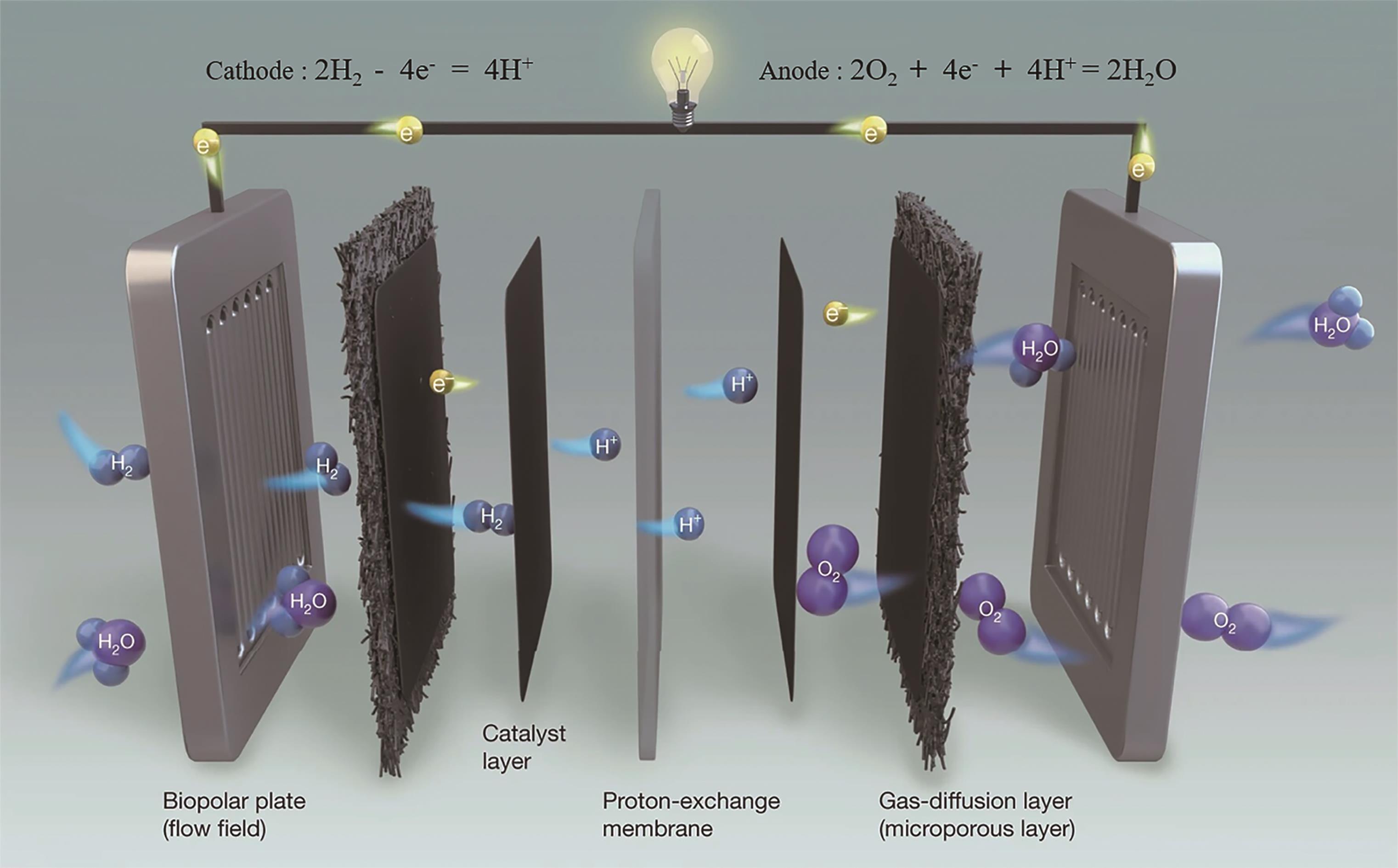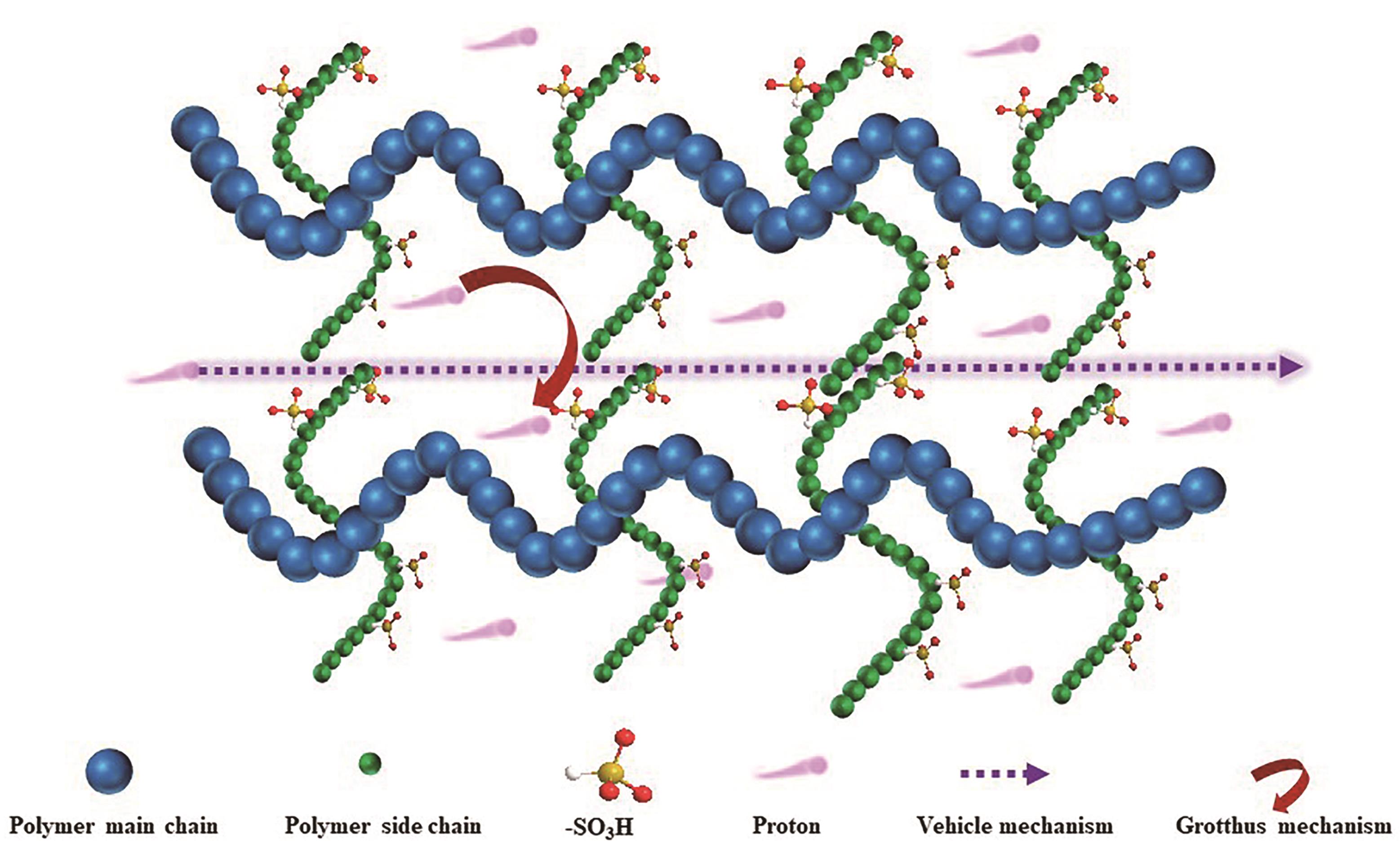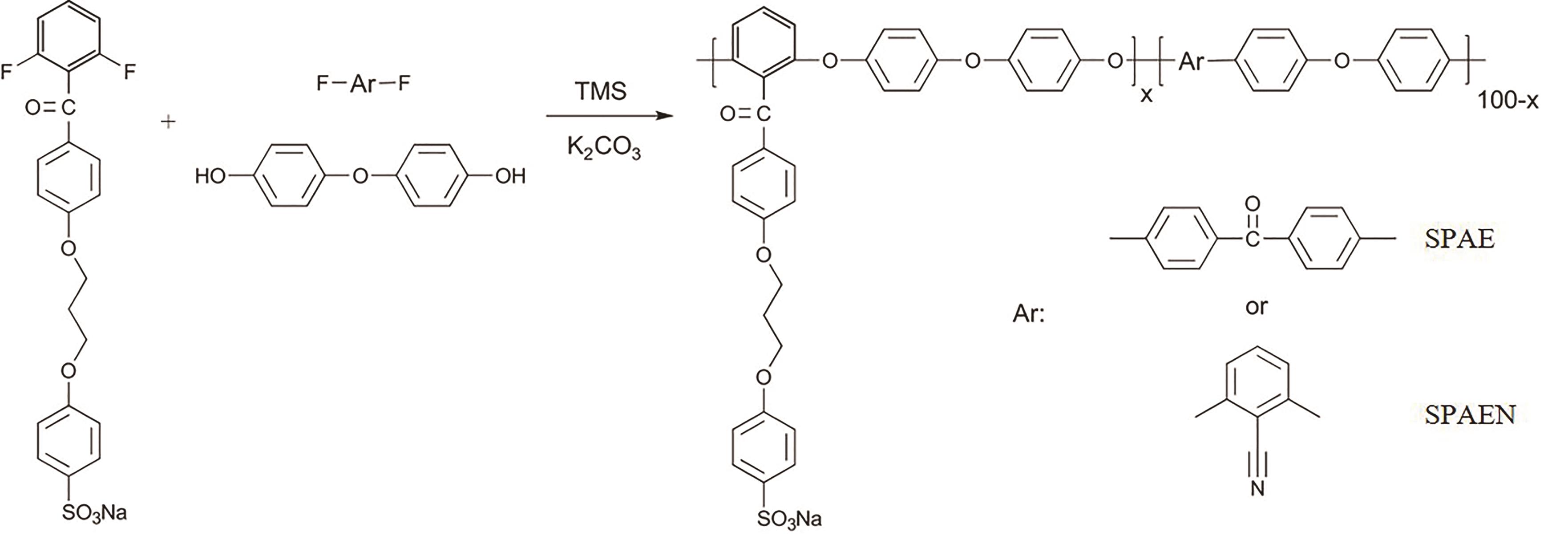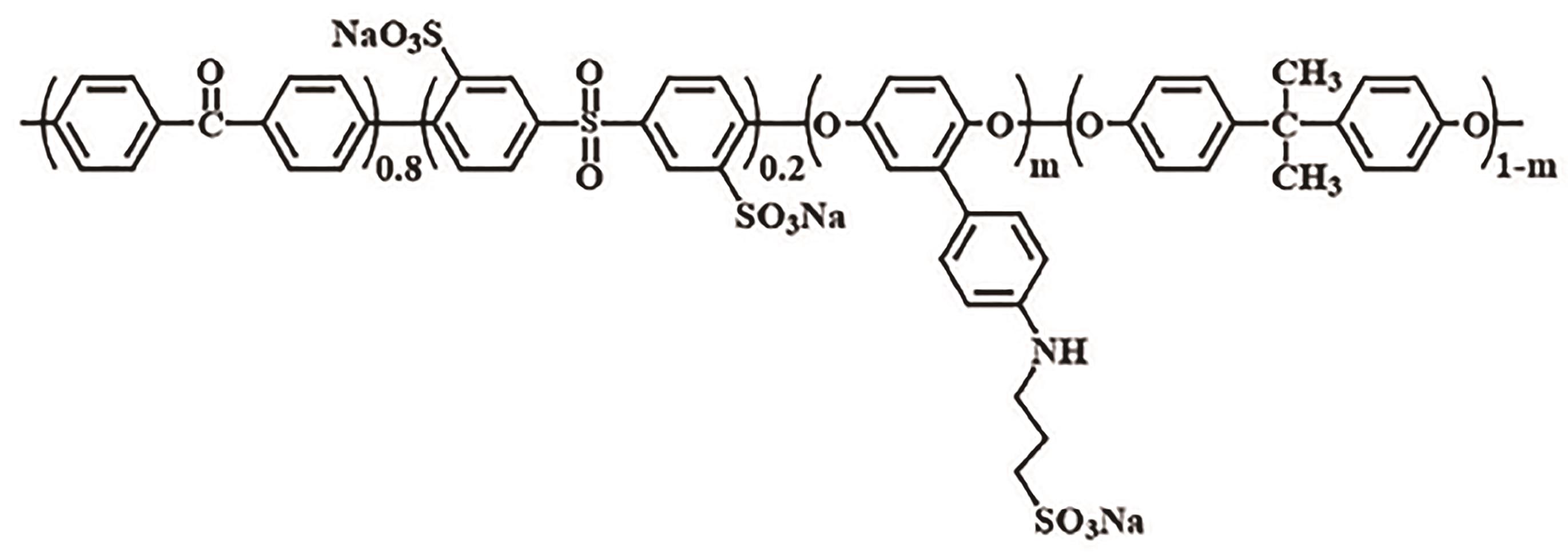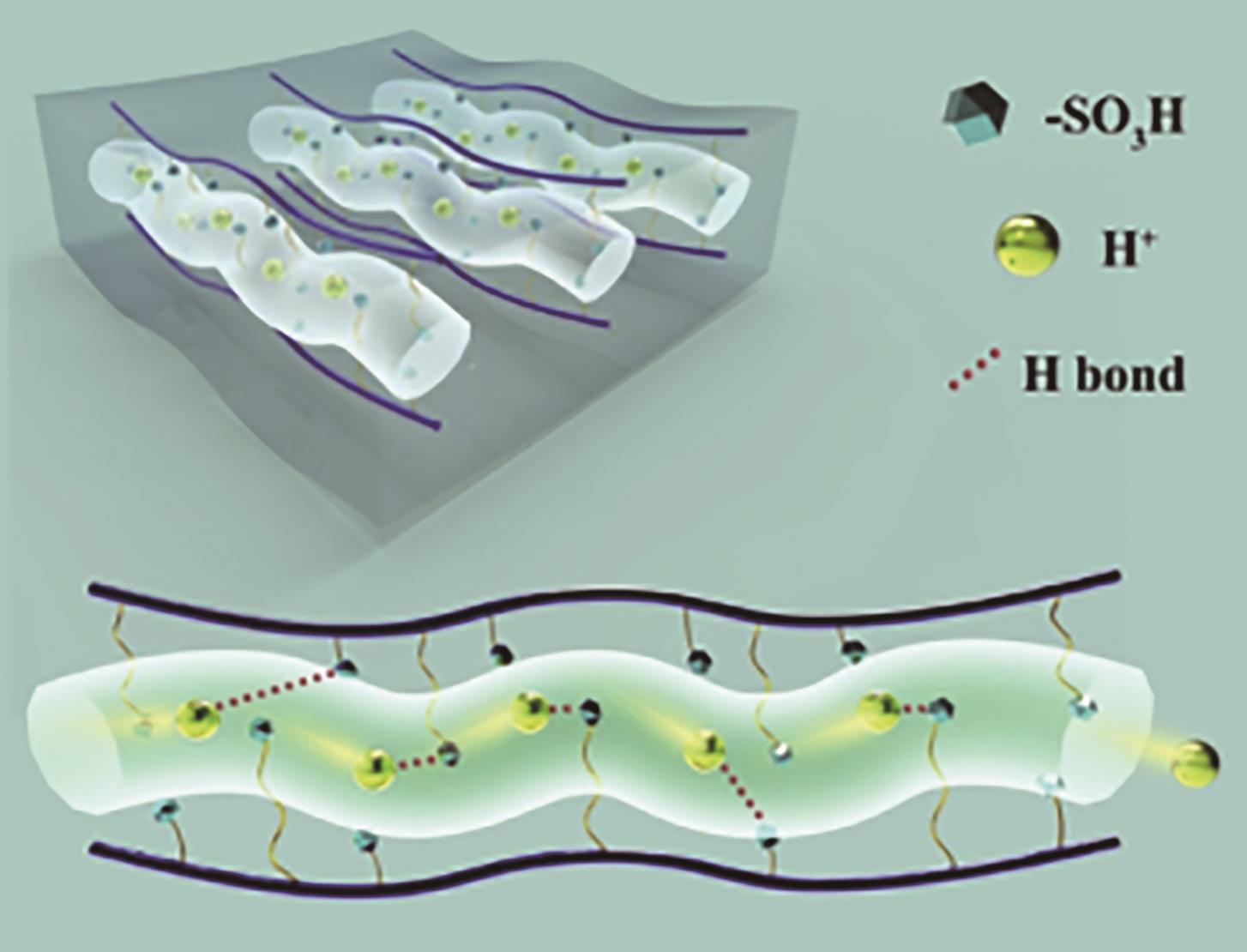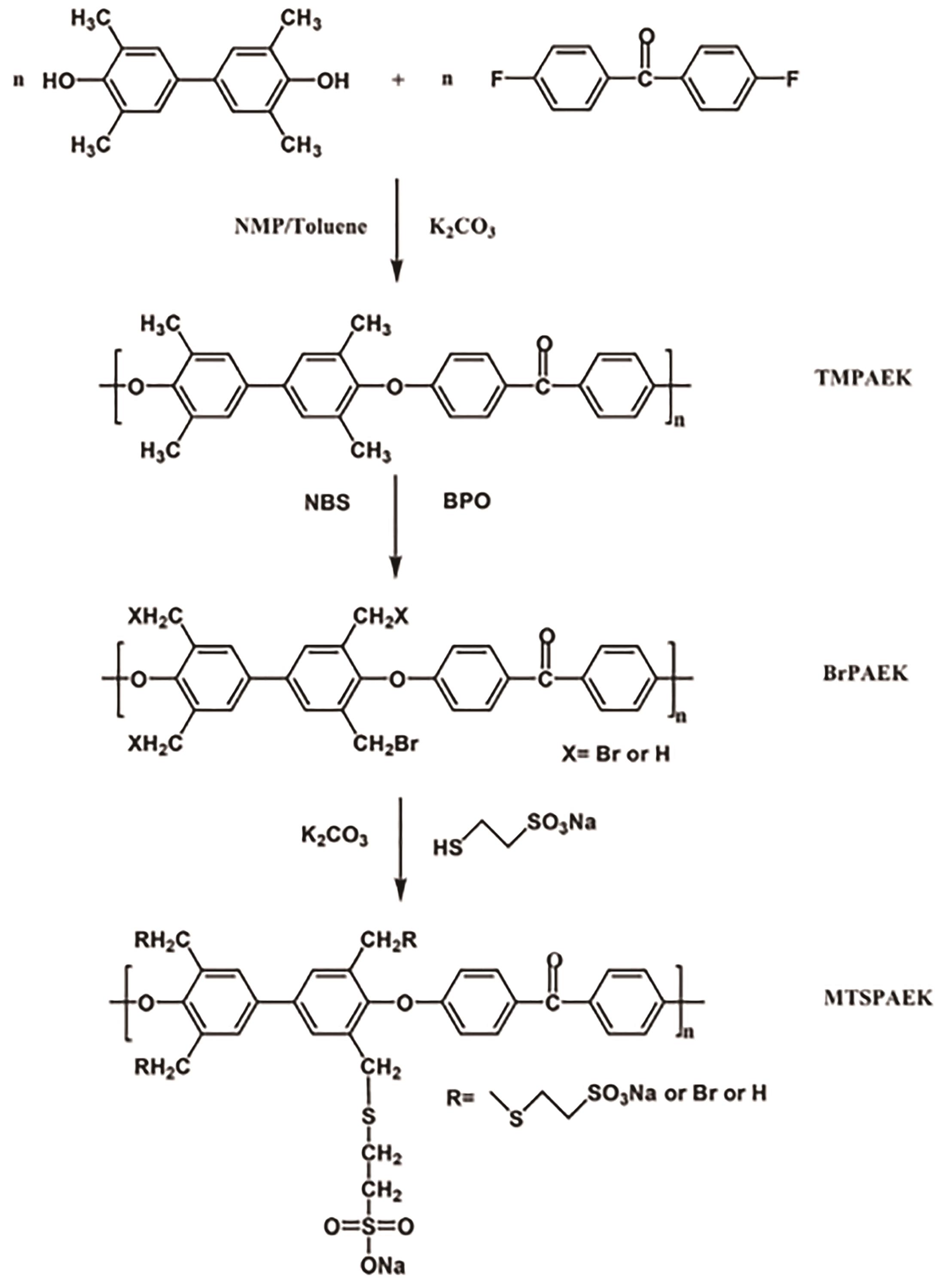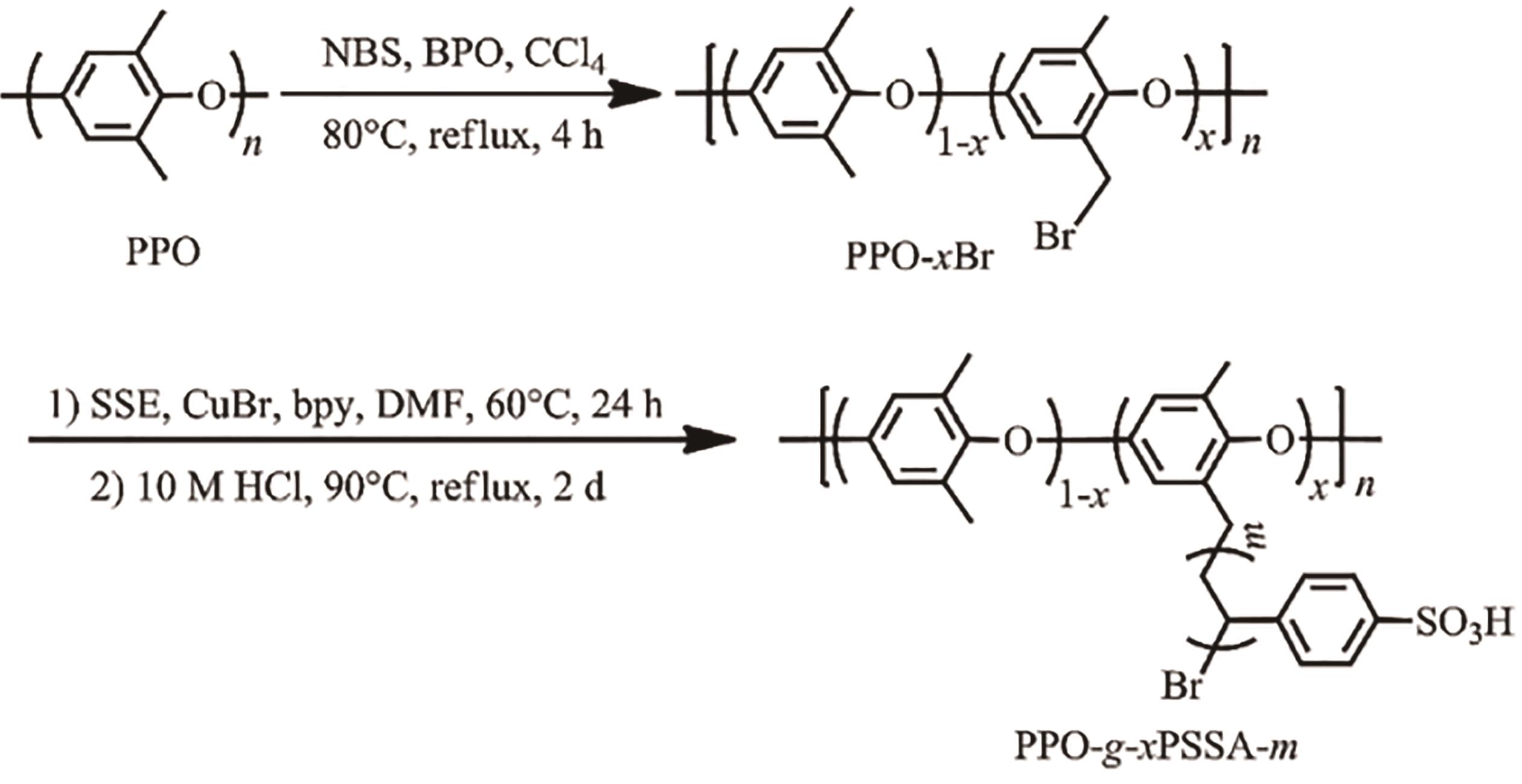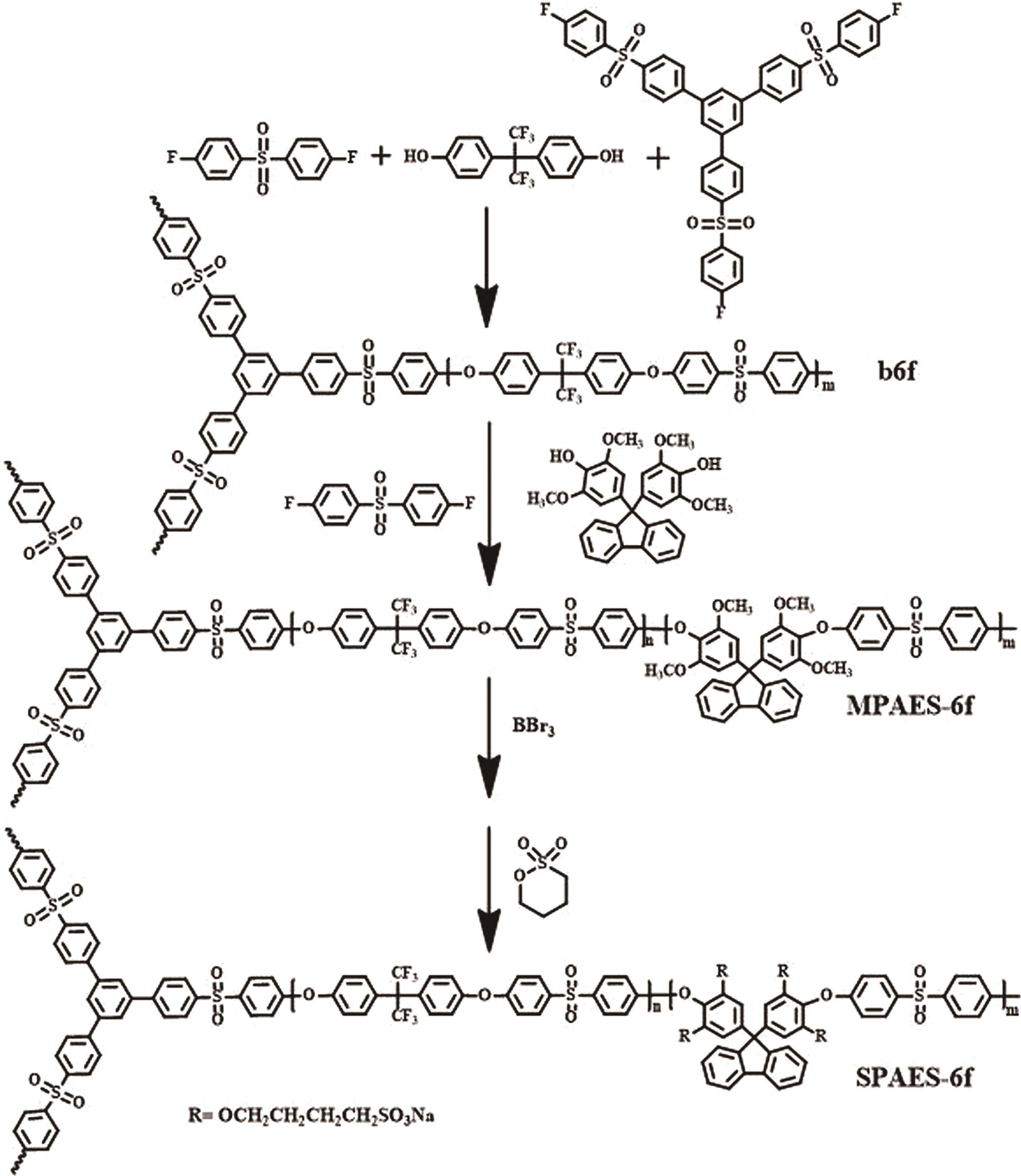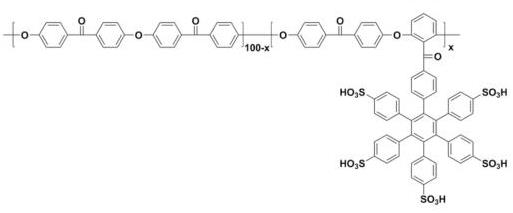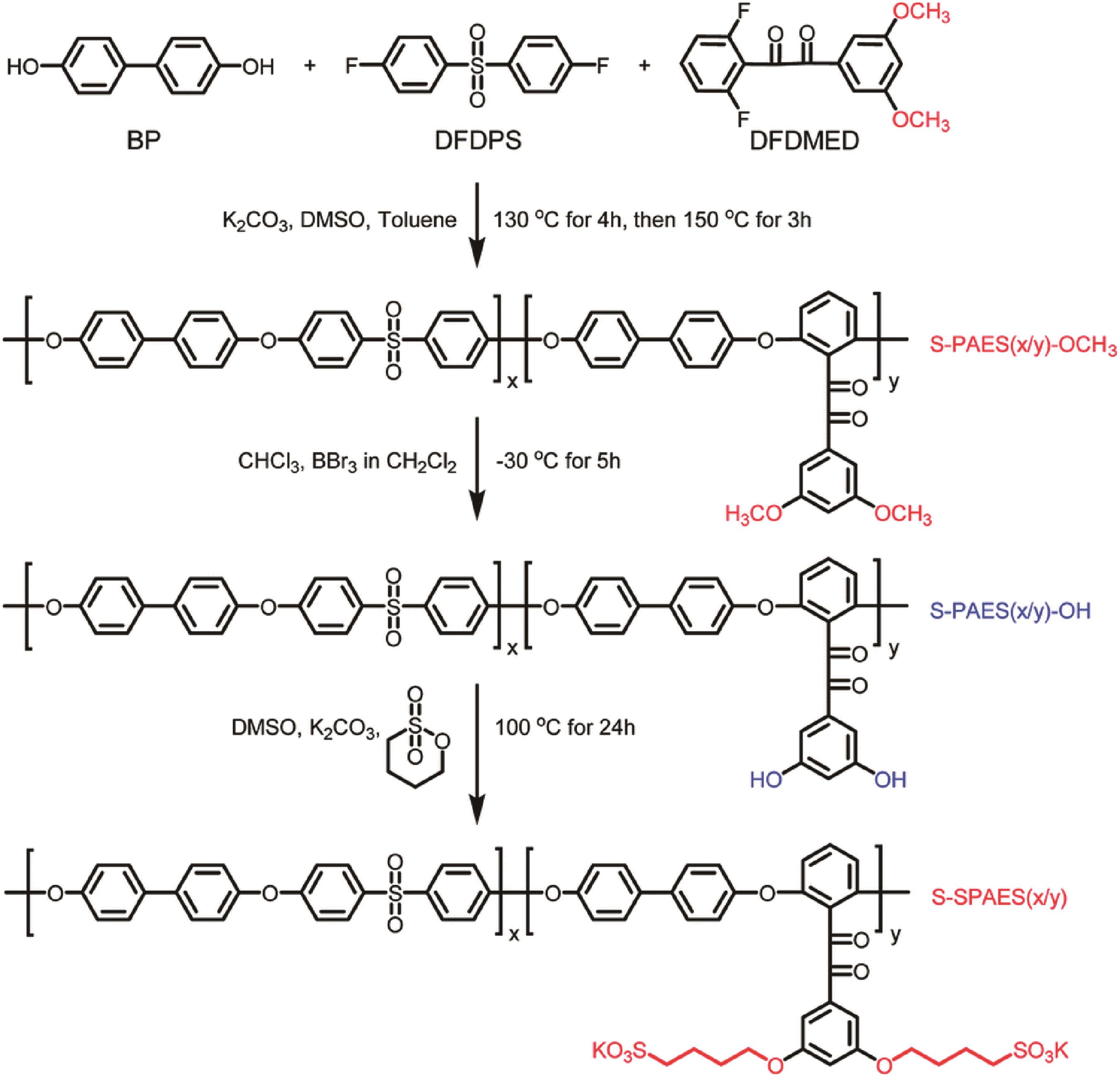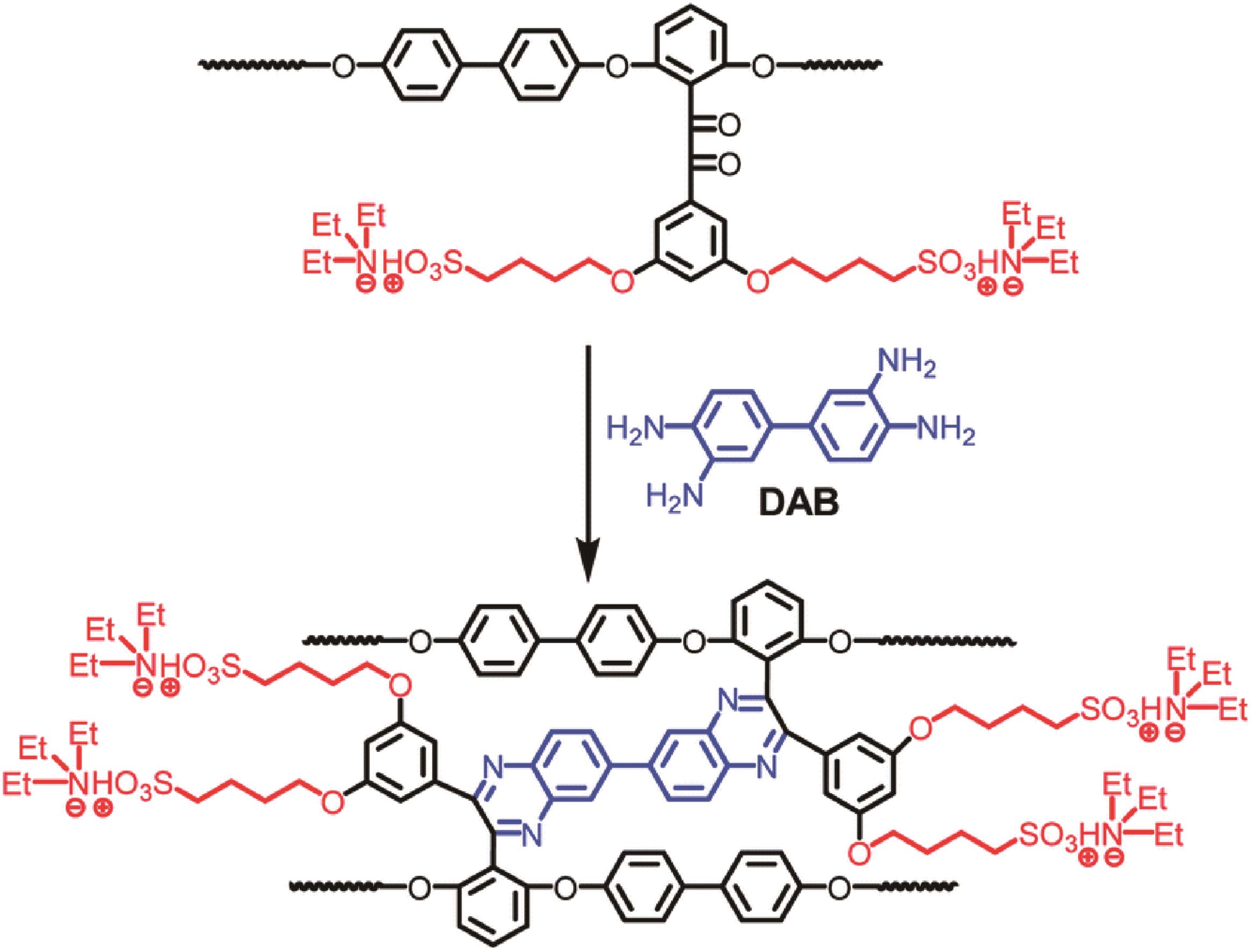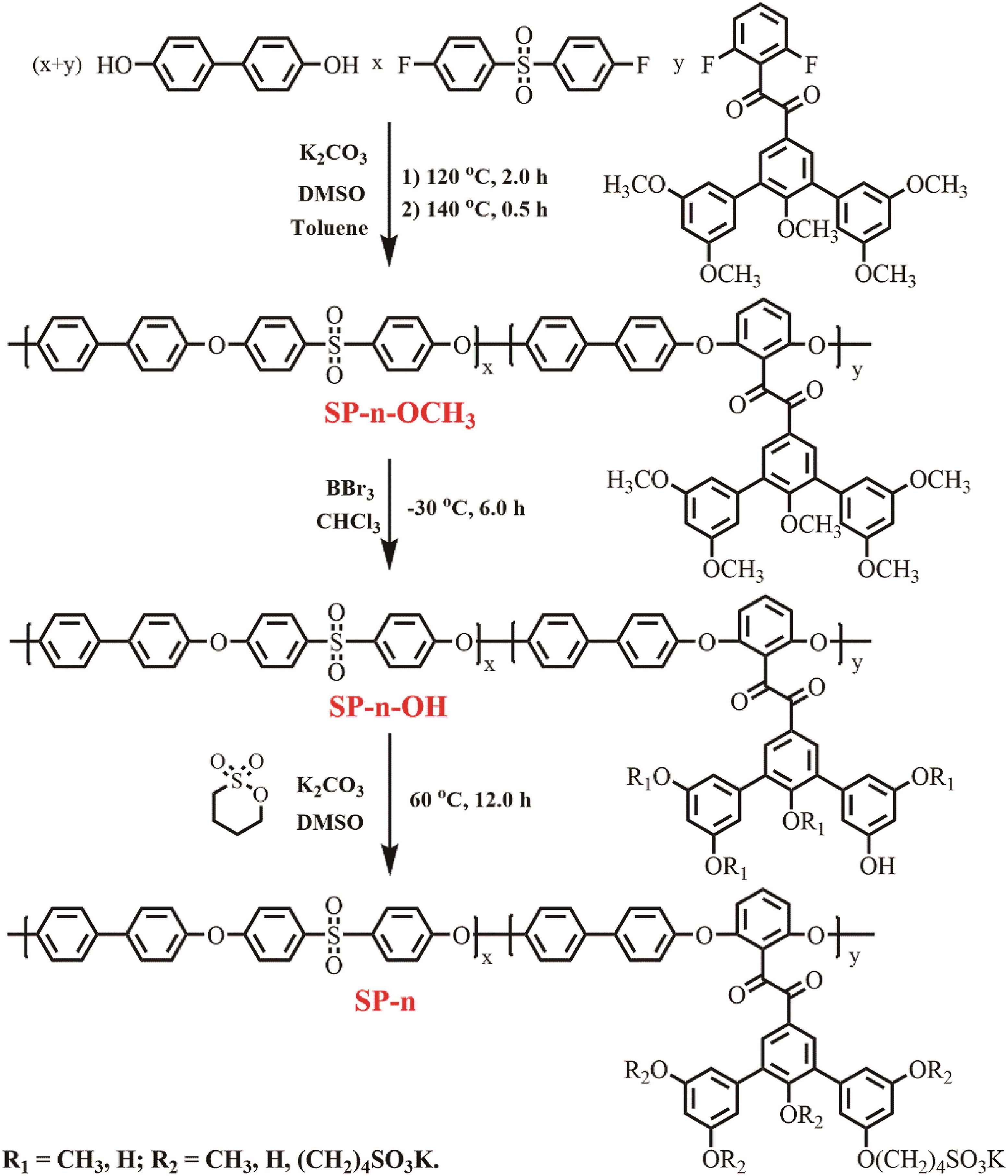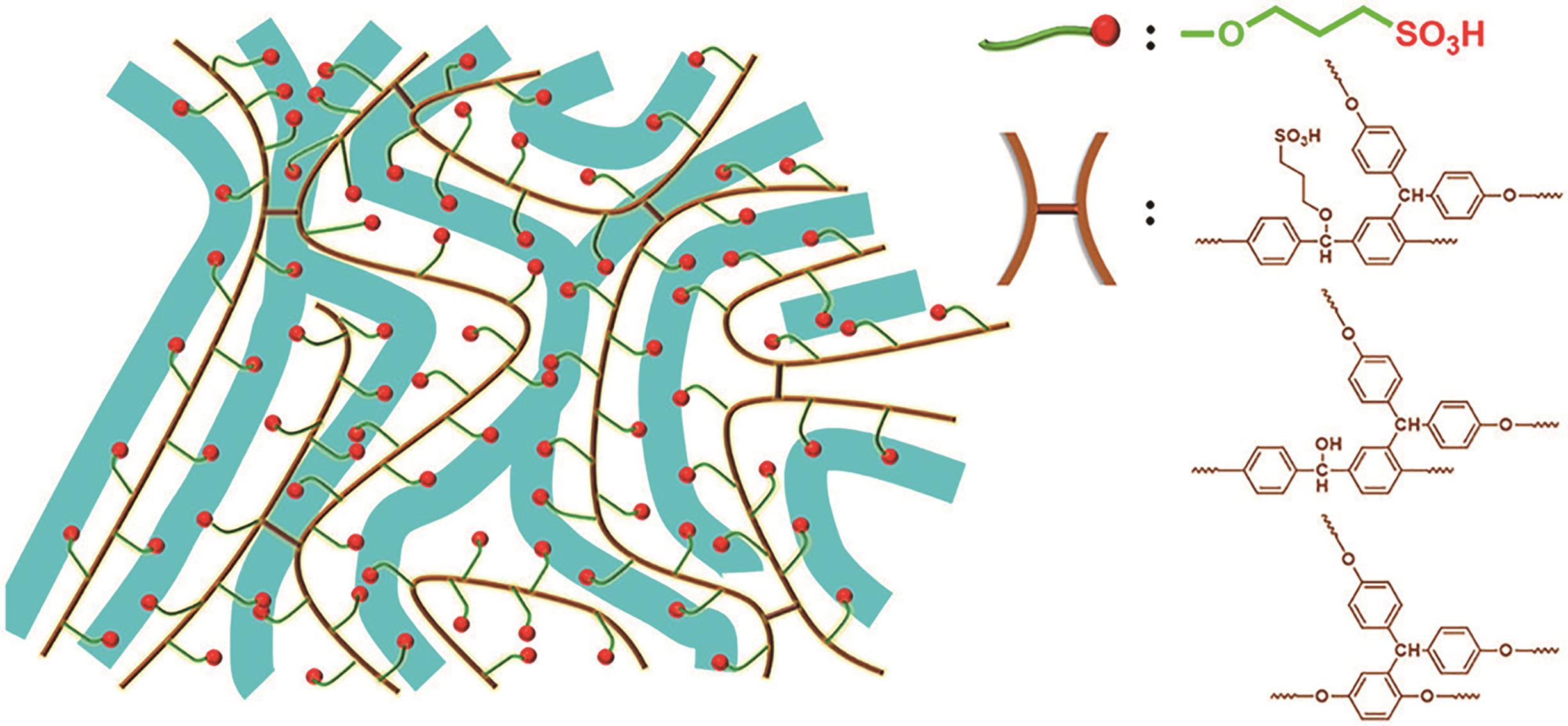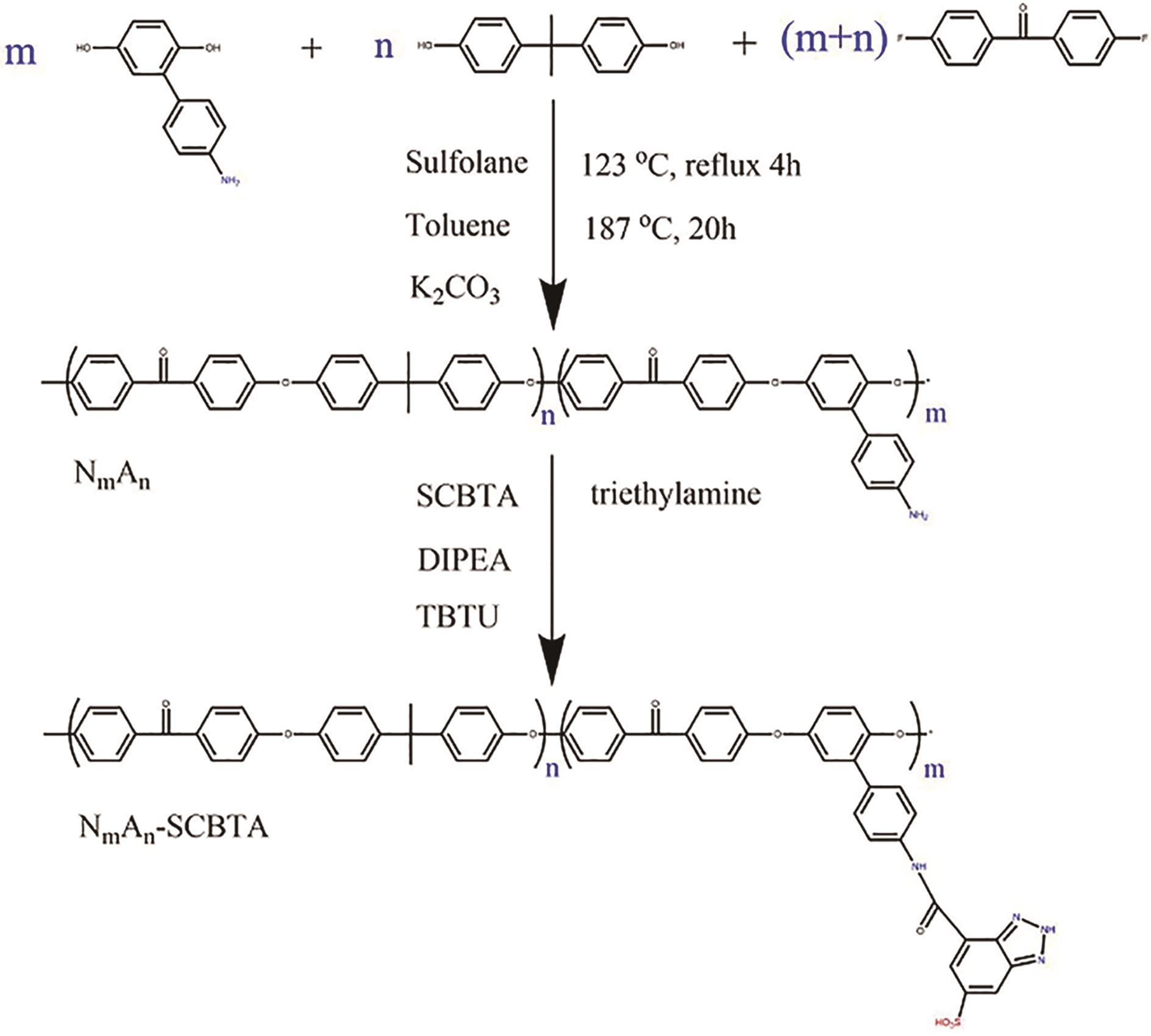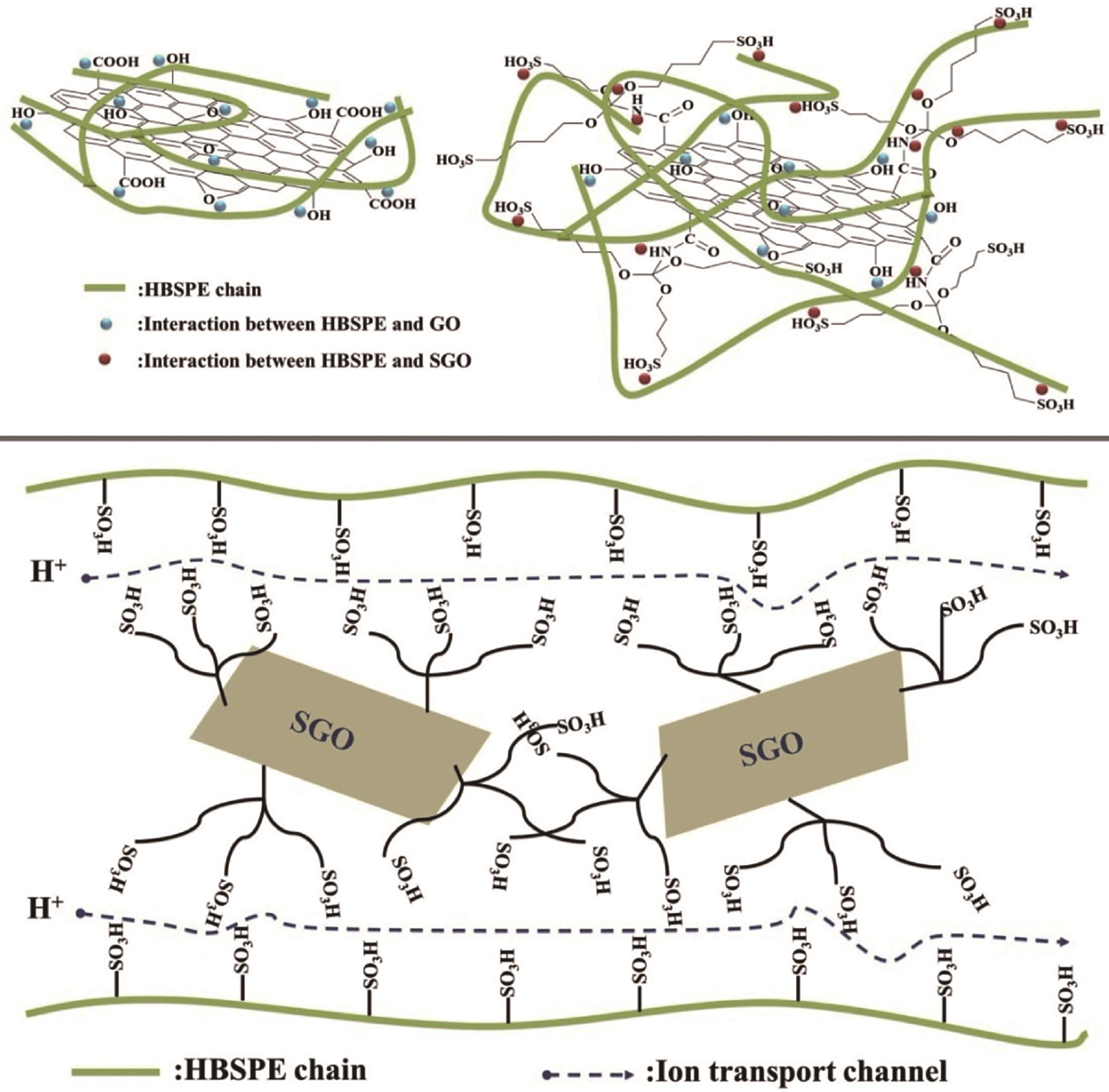
Chinese Journal of Applied Chemistry ›› 2022, Vol. 39 ›› Issue (12): 1783-1802.DOI: 10.19894/j.issn.1000-0518.220114
• Review • Next Articles
Research Progress of Side-Chain Sulfonated Polyarylene Ether Proton Exchange Membranes
Tong CAO1,2, Jun PENG1,2, Yan FENG3, Xiao-Bo LIU1,2( ), Yu-Min HUANG1,2(
), Yu-Min HUANG1,2( )
)
- 1.School of Materials and Energy,University of Electronic Science and Technology of China,Chengdu 611731,China
2.Sichuan Province Engineering Technology Research Center of Novel CN Polymeric Materials,Chengdu 611731,China
3.Shenzhen Extender Co. ,Ltd,Shenzhen 518103,China
-
Received:2022-04-07Accepted:2022-09-04Published:2022-12-01Online:2022-12-13 -
Contact:Xiao-Bo LIU,Yu-Min HUANG -
About author:hym@uestc.edu.cn
liuxb@uestc.edu.cn
-
Supported by:the National Natural Science Foundation of China(21805027);Sichuan Science and Technology Program(2019YJ0197)
CLC Number:
Cite this article
Tong CAO, Jun PENG, Yan FENG, Xiao-Bo LIU, Yu-Min HUANG. Research Progress of Side-Chain Sulfonated Polyarylene Ether Proton Exchange Membranes[J]. Chinese Journal of Applied Chemistry, 2022, 39(12): 1783-1802.
share this article

Fig.4 Morphology of SPAE-1,3 and SPAEN-1,3 ionomers studied by TEM. (A) SPAE-1, DS=0.74; (B) SPAE-3, DS=0.92; (C) SPAEN-1, DS=0.68; (D) SPAEN-3, DS=0.90[42]
质子交换膜 Proton exchange membrane | 质子电导率 Proton conductivity/ (mS·cm-1) | 离子交换容量 Ion-exchange capacity/ (mmol·g-1) | 吸水率 Water uptake/ % | 燃料电池性能 Fuel cell performance/(mW·cm-2) | 温度 Temperature/ ℃ | 相对湿度 Relative humidity/% | 参考文献 Ref. |
|---|---|---|---|---|---|---|---|
| GSPHP 25 | 102.6 | 1.47 | 60.28 | 620.0 | 80 | 90 | [ |
| PPO-g-0.08PPSA-13 | 45.5 | 3.24 | / | / | 95 | 90 | [ |
SPAEK(X9.1Y8.8) PPEK-M20N10-SO3H | 154.1 150.0 | 2.01 | 70.00 | 323.9 | 60 | 100 | [ |
| 1.41 | 25.60 | 768.0 | 70 | 80 | [ | ||
| SPAES-6f | 420.0 | 1.60 | 59.50 | / | 80 | 100 | [ |
| SPDCP-1.5 | 248.2 | 1.52 | 33.80 | / | 90 | 100 | [ |
| CSP-1 | 215.0 | 1.72 | 27.80 | 1 660.0 | 70 | 65 | [ |
| SPEEK74-O-PA100 | 200.3 | / | 12.60 | 527.0 | 65 | 100 | [ |
| Nafion 211 | 102.8 | 0.90 | 32.13 | 630.0 | 80 | 90 | [ |
| Nafion 115 | 131.5 | 0.92 | 35.00 | 291.4 | 60 | 100 | [ |
| Nafion 212 | 142.0 | 0.91 | 15.40 | 744.0 | 70 | 80 | [ |
Table 1 Comparison of the main properties of proton exchange membranes based on hydrogen fuel cell appearing in this paper
质子交换膜 Proton exchange membrane | 质子电导率 Proton conductivity/ (mS·cm-1) | 离子交换容量 Ion-exchange capacity/ (mmol·g-1) | 吸水率 Water uptake/ % | 燃料电池性能 Fuel cell performance/(mW·cm-2) | 温度 Temperature/ ℃ | 相对湿度 Relative humidity/% | 参考文献 Ref. |
|---|---|---|---|---|---|---|---|
| GSPHP 25 | 102.6 | 1.47 | 60.28 | 620.0 | 80 | 90 | [ |
| PPO-g-0.08PPSA-13 | 45.5 | 3.24 | / | / | 95 | 90 | [ |
SPAEK(X9.1Y8.8) PPEK-M20N10-SO3H | 154.1 150.0 | 2.01 | 70.00 | 323.9 | 60 | 100 | [ |
| 1.41 | 25.60 | 768.0 | 70 | 80 | [ | ||
| SPAES-6f | 420.0 | 1.60 | 59.50 | / | 80 | 100 | [ |
| SPDCP-1.5 | 248.2 | 1.52 | 33.80 | / | 90 | 100 | [ |
| CSP-1 | 215.0 | 1.72 | 27.80 | 1 660.0 | 70 | 65 | [ |
| SPEEK74-O-PA100 | 200.3 | / | 12.60 | 527.0 | 65 | 100 | [ |
| Nafion 211 | 102.8 | 0.90 | 32.13 | 630.0 | 80 | 90 | [ |
| Nafion 115 | 131.5 | 0.92 | 35.00 | 291.4 | 60 | 100 | [ |
| Nafion 212 | 142.0 | 0.91 | 15.40 | 744.0 | 70 | 80 | [ |
质子交换膜 Proton exchange membrane | 质子电导率 Proton conductivity/ (mS·cm-1) | 离子交换容量 Ion-exchange capacity/ (mmol·g-1) | 吸水率 Water uptake/% | 燃料电池性能 Fuel cell performance/ (mW·cm-2) | 温度 Temperature/ ℃ | 相对湿度 Relative humidity/ % | 甲醇渗透率 Methanol permeability/ (cm2·s-1) | 参考文献 Ref. |
|---|---|---|---|---|---|---|---|---|
| SPAE-3 | 120.0 | 1.50 | 79.60 | / | 100 | 100 | 2.90×10-7 | [ |
SPAEKS-PSA15 MTSPAEK-2.10 | 101.0 181.0 | 0.78 | 15.72 | 30.50 | 80 | 100 | 9.44×10-7 | [ |
| 2.57 | 87.00 | 70.00 | 80 | 100 | 7.80×10-7 | [ | ||
| PEK-SP20 | 100.0 | 1.78 | 34.10 | 45.50 | 80 | 100 | 3.60×10-7 | [ |
| S-SPAES(1/2) | 180.0 | 2.01 | 46.20 | 314.5 | 60 | 100 | 7.12×10-7 | [ |
| N7A3-SCBTA | 89.0 | 1.81 | 20.00 | / | 90 | 100 | 0.79×10-7 | [ |
| MNS@SNF-PAEK-3% | 192.0 | 1.85 | 73.34 | 125.70 | 80 | 100 | 5.28×10-7 | [ |
| HBSPE/SGO 0.50 | 355.0 | 1.74 | 39.00 | 82.36 | 80 | 100 | 7.87×10-7 | [ |
| Nafion117 | 30.2 | 0.80 | 19.60 | 21.30 | 80 | 100 | 1.22×10-6 | [ |
Table 2 Comparison of the main properties of proton exchange membranes based on methanol fuel cell appearing in this paper
质子交换膜 Proton exchange membrane | 质子电导率 Proton conductivity/ (mS·cm-1) | 离子交换容量 Ion-exchange capacity/ (mmol·g-1) | 吸水率 Water uptake/% | 燃料电池性能 Fuel cell performance/ (mW·cm-2) | 温度 Temperature/ ℃ | 相对湿度 Relative humidity/ % | 甲醇渗透率 Methanol permeability/ (cm2·s-1) | 参考文献 Ref. |
|---|---|---|---|---|---|---|---|---|
| SPAE-3 | 120.0 | 1.50 | 79.60 | / | 100 | 100 | 2.90×10-7 | [ |
SPAEKS-PSA15 MTSPAEK-2.10 | 101.0 181.0 | 0.78 | 15.72 | 30.50 | 80 | 100 | 9.44×10-7 | [ |
| 2.57 | 87.00 | 70.00 | 80 | 100 | 7.80×10-7 | [ | ||
| PEK-SP20 | 100.0 | 1.78 | 34.10 | 45.50 | 80 | 100 | 3.60×10-7 | [ |
| S-SPAES(1/2) | 180.0 | 2.01 | 46.20 | 314.5 | 60 | 100 | 7.12×10-7 | [ |
| N7A3-SCBTA | 89.0 | 1.81 | 20.00 | / | 90 | 100 | 0.79×10-7 | [ |
| MNS@SNF-PAEK-3% | 192.0 | 1.85 | 73.34 | 125.70 | 80 | 100 | 5.28×10-7 | [ |
| HBSPE/SGO 0.50 | 355.0 | 1.74 | 39.00 | 82.36 | 80 | 100 | 7.87×10-7 | [ |
| Nafion117 | 30.2 | 0.80 | 19.60 | 21.30 | 80 | 100 | 1.22×10-6 | [ |
| 1 | CAPELLAN-PEREZ I, MEDIAVILLA M, DE CASTRO C, et al. Fossil fuel depletion and socio-economic scenarios: an integrated approach[J]. Energy, 2014, 77: 641-666. |
| 2 | PAN M Z, PAN C J, LI C, et al. A review of membranes in proton exchange membrane fuel cells: transport phenomena, performance and durability[J]. Renew Sust Energ Rev, 2021, 141: 110771. |
| 3 | XING L, SHI W D, SU H N, et al. Membrane electrode assemblies for PEM fuel cells: a review of functional graded design and optimization[J]. Energy, 2019, 177: 445-464. |
| 4 | OGUNGBEMI E, WILBERFORCE T, LJAODOLA O, et al. Selection of proton exchange membrane fuel cell for transportation[J]. Int J Hydrog Energy, 2021, 46(59): 30625-30640. |
| 5 | HAIDER R, WEM Y C, MA Z F, et al. High temperature proton exchange membrane fuel cells: progress in advanced materials and key technologies[J]. Chem Soc Rev, 2021, 50(2): 1138-1187. |
| 6 | WANG Y, DIAR D, CHEN K S, et al. Materials, technological status, and fundamentals of PEM fuel cells-a review[J]. Mater Today, 2020, 32: 178-203. |
| 7 | JIAO K, XUAN J, DU Q, et al. Designing the next generation of proton-exchange membrane fuel cells[J]. Nature, 2021, 595(7867): 361-369. |
| 8 | QU E L, HAO X F, XIAO M, et al. Proton exchange membranes for high temperature proton exchange membrane fuel cells: challenges and perspectives[J]. J Power Sources, 2022, 533: 231386. |
| 9 | LI G Q, KUJAWSKI W, RYNKOWSKA E. Advancements in proton exchange membranes for high-performance high-temperature proton exchange membrane fuel cells (HT-PEMFC)[J]. Rev Chem Eng, 2022, 38(3): 327-346. |
| 10 | CHEN Z C, GUO L, PAN L, et al. Advances in oxygen evolution electrocatalysts for proton exchange membrane water electrolyzers[J]. Adv Energy Mater, 2022, 12(14): 2103670. |
| 11 | LIU Q S, LAN F C, CHEN J Q, et al. A review of proton exchange membrane fuel cell water management: membrane electrode assembly[J]. J Power Sources, 2021, 517: 230723. |
| 12 | LAEDRE S, KONGSTEIN O E, OEDEGAARD A, et al. Materials for proton exchange membrane water electrolyzer bipolar plates[J]. Int J Hydrog Energy, 2017, 42(5): 2713-2723. |
| 13 | SUTRADHAR S C, JANG H, BANIK N, et al. Synthesis and characterization of proton exchange poly(phenylenebenzophenone)s membranes grafted with propane sulfonic acid on pendant phenyl groups[J]. Int J Hydrog Energy, 2017, 42(17): 12749-12758. |
| 14 | WANG G, GUIVER M D. Proton exchange membranes derived from sulfonated polybenzothiazoles containing naphthalene units[J]. J Membr Sci, 2017, 542: 159-167. |
| 15 | HILD S, GUTMANNSBAUER W, LUTH R, et al. A nanoscopic view of structure and deformation of hard elastic polypropylene with scanning force microscopy[J]. J Polym Sci Pol Phys, 1996, 34(12): 1953-1959. |
| 16 | AHMAD H, KAMARUDIN S K, HASRAN U A, et al. Overview of hybrid membranes for direct-methanol fuel-cell applications[J]. Int J Hydrog Energy, 2010, 35(5): 2160-2175. |
| 17 | DEVANATHAN R. Recent developments in proton exchange membranes for fuel cells[J]. Energy Environ Sci, 2008, 1(1): 101-119. |
| 18 | DUPUIS A C. Proton exchange membranes for fuel cells operated at medium temperatures: materials and experimental techniques[J]. Prog Mater Sci, 2011, 56(3): 289-327. |
| 19 | ELABD Y A, HICKNER M A. Block copolymers for fuel cells[J]. Macromolecules, 2011, 44(1): 1-11. |
| 20 | KREUER K D. On the development of proton conducting polymer membranes for hydrogen and methanol fuel cells[J]. J Membr Sci, 2001, 185(1): 29-39. |
| 21 | MIYATAKE K, IYOTANI H, YAMAMOTO K, et al. Synthesis of poly(phenylene sulfide sulfonic acid) via poly(sulfonium cation) as a thermostable proton-conducting polymer[J]. Macromolecules, 1996, 29(21): 6969-6971. |
| 22 | PARK C H, LEE C H, GUIVER M D, et al. Sulfonated hydrocarbon membranes for medium-temperature and low-humidity proton exchange membrane fuel cells (PEMFCs)[J]. Prog Polym Sci, 2011, 36(11): 1443-1498. |
| 23 | XU T W, WU D, WU L. Poly(2,6-dimethyl-1,4-phenylene oxide) (PPO)-a versatile starting polymer for proton conductive membranes (PCMs)[J]. Prog Polym Sci, 2008, 33(9): 894-915. |
| 24 | INZELT G, PINERI M, SCHULTZE J W, et al. Electron and proton conducting polymers: recent developments and prospects[J]. Electrochim Acta, 2000, 45(15/16): 2403-2421. |
| 25 | DU N Y, ROBERTSON G P, PINNAU I, et al. Polymers of intrinsic microporosity with dinaphthyl and thianthrene segments[J]. Macromolecules, 2010, 43(20): 8580-8587. |
| 26 | FUJIMOTO C H, HICKNER M A, CORNELIUS C J, et al. Ionomeric poly(phenylene) prepared by diels-alder polymerization: synthesis and physical properties of a novel polyelectrolyte[J]. Macromolecules, 2005, 38(12): 5010-5016. |
| 27 | LIU B J, ROBERTSON G P, KIM D S, et al. Aromatic poly(ether ketone)s with pendant sulfonic acid phenyl groups prepared by a mild sulfonation method for proton exchange membranes[J]. Macromolecules, 2007, 40(6): 1934-1944. |
| 28 | MIYATAKE K, OYAIZU K, TSUCHIDA E, et al. Synthesis and properties of novel sulfonated arylene ether/fluorinated alkane copolymers[J]. Macromolecules, 2001, 34(7): 2065-2071. |
| 29 | SEESUKPHRONRARAK S, OHIRA K, KIDENA K, et al. Synthesis and properties of sulfonated copoly(p-phenylene)s containing aliphatic alkyl pendant for fuel cell applications[J]. Polymer, 2010, 51(3): 623-631. |
| 30 | 乔宗文, 陈涛. 燃料电池用侧链型磺化聚砜质子交换膜的性能[J]. 应用化学, 2019, 36(8): 917-923. |
| QIAO Z W CHEN T. Properties of side chain type sulfonated polysulfone proton exchange membranes for fuel cells[J]. Chinese J Appl Chem, 2019, 36(8): 917-923. | |
| 31 | KREUER K, ALBRECHT R, WERNER W, et al. Vehicle mechanism, a new model for the interpretation of the conductivity of fast proton conductors[J]. Angew Chem Int Ed, 1982, 21(3): 208-209. |
| 32 | KREUER K D, PADDISON S J, SPOHR E, et al. Transport in proton conductors for fuel-cell applications: simulations, elementary reactions, and phenomenology[J]. Chem Rev, 2004, 104(10): 4637-4678. |
| 33 | JIN C H, ZHU X L, ZHANG S, et al. Highly conductive flexible alkylsulfonated side chains poly(phthalazinone ether ketone)s for proton exchange membranes[J]. Polymer, 2018, 148: 269-277. |
| 34 | LI J L, BU F Z, RU C Y, et al. Enhancing the selectivity of Nafion membrane by incorporating a novel functional skeleton molecule to improve the performance of direct methanol fuel cells[J]. J Mater Chem A, 2020, 8(1): 196-206. |
| 35 | LIM Y, SEO D, HOSSAIN M A, et al. Preparation and characterization of proton exchange poly(ether sulfone)s membranes grafted propane sulfonic acid on pendant phenyl groups[J]. Electrochim Acta, 2014, 118: 18-25. |
| 36 | LIU D J, ZHONG H Y, WANG G Q, et al. Nonparaxial propagation of a partially coherent four-petal Gaussian vortex beam[J]. Optik, 2018, 158: 451-459. |
| 37 | WANG C Y, LEE S Y, SHIN D W, et al. Proton-conducting membranes from poly(ether sulfone)s grafted with sulfoalkylamine[J]. J Membr Sci, 2013, 427: 443-450. |
| 38 | LEE S Y, SHIN D W, WANG C, et al. A capillary water retention effect to improve medium-temperature fuel cell performance[J]. Electrochem Commun, 2013, 31: 120-124. |
| 39 | PANG J H, ZHANG H B, JIANG Z H, et al. Novel wholly aromatic sulfonated poly(arylene ether) copolymers containing sulfonic acid groups on the pendants for proton exchange membrane materials[J]. Macromolecules, 2007, 40(26): 9435-9442. |
| 40 | PANG J H, ZHANG H B, LI X F, et al. Low water swelling and high proton conducting sulfonated poly(arylene ether) with pendant sulfoalkyl groups for proton exchange membranes[J]. Macromol Rapid Commun, 2007, 28(24): 2332-2338. |
| 41 | PANG J H, LIU B J, JIANG Z H, et al. Synthesis and characterization of sulfonated poly(arylene ether)s with sulfoalkyl pendant groups for proton exchange membranes[J]. J Membr Sci, 2008, 318(1/2): 271-279. |
| 42 | ZHANG Q, LIU B J, HU W, et al. Poly(arylene ether) electrolyte membranes bearing aliphatic-chain-linked sulfophenyl pendant groups[J]. J Membr Sci, 2013, 428: 629-638. |
| 43 | LIU C, WANG X, XU J M, et al. PEMs with high proton conductivity and excellent methanol resistance based on sulfonated poly(aryl ether ketone sulfone) containing comb-shaped structures for DMFCs applications[J]. Int J Hydrog Energy, 2020, 45(1): 945-957. |
| 44 | LI X F, BU F Z, ZHANG H Q, et al. Facile synthesis of poly (arylene ether ketone)s containing flexible sulfoalkyl groups with enhanced oxidative stability for DMFCs[J]. Int J Hydrog Energy, 2020, 45(51): 27632-27643. |
| 45 | ZENG G B, ZHANG D Q, YAN L M, et al. Design and synthesis of side-chain optimized poly(2,6-dimethyl-1,4-phenylene oxide)-g-poly(styrene sulfonic acid) as proton exchange membrane for fuel cell applications: balancing the water-resistance and the sulfonation degree[J]. Int J Hydrog Energy, 2021, 46(39): 20664-20677. |
| 46 | KHOMEIN P, KETELAARS W, LAP T, et al. Sulfonated aromatic polymer as a future proton exchange membrane: a review of sulfonation and crosslinking methods[J]. Renew Sust Energ Rev, 2021, 137: 110471. |
| 47 | ROY A, HICKNER M A, YU X, et al. Influence of chemical composition and sequence length on the transport properties of proton exchange membranes[J]. J Polym Sci Pol Phys, 2006, 44(16): 2226-2239. |
| 48 | 毕伟辉, 郑吉富, 张所波. 磺化聚苯醚酮质子交换膜的制备与表征[J]. 应用化学, 2017, 34(10): 1117-1126. |
| BI W H, ZHENG J F, ZHANG S B. Preparation and characterization of sulfonated poly(p-phenylene-co-aryl ether ketone) for proton exchange membranes[J]. Chinese J Appl Chem, 2017, 34(10): 1117-1126. | |
| 49 | MEIER-HAACK J, TAEGER A, VOGEL C, et al. Membranes from sulfonated block copolymers for use in fuel cells[J]. Sep Purif Technol, 2005, 41(3): 207-220. |
| 50 | LEE K H, CHU J Y, KIM A R, et al. Enhanced performance of a sulfonated poly(arylene ether ketone) block copolymer bearing pendant sulfonic acid groups for polymer electrolyte membrane fuel cells operating at 80% relative humidity[J]. ACS Appl Mater Interfaces, 2018, 10(24): 20835-20844. |
| 51 | DONG T D, HU J H, UEDA M, et al. Enhanced proton conductivity of multiblock poly(phenylene ether ketone)s via pendant sulfoalkoxyl side chains with excellent H-2/air fuel cell performance[J]. J Mater Chem A, 2016, 4(6): 2321-2331. |
| 52 | XIE H X, TAO D, NI J P, et al. Synthesis and properties of highly branched star-shaped sulfonated block polymers with sulfoalkyl pendant groups for use as proton exchange membranes[J]. J Membr Sci, 2016, 497: 55-66. |
| 53 | SEO D W, LIM Y D, LEE S H, et al. Preparation and characterization of sulfonated poly(tetra phenyl ether ketone sulfone)s for proton exchange membrane fuel cell[J]. Int J Hydrog Energy, 2012, 37(7): 6140-6147. |
| 54 | BOSE S, KUILA T, NGUYEN T, et al. Polymer membranes for high temperature proton exchange membrane fuel cell: recent advances and challenges[J]. Prog Polym Sci, 2011, 36(6): 813-843. |
| 55 | LIU D, DONG B, ZHANG H B, et al. High methanol resistant polyelectrolyte membrane based on semi-crystalline poly(ether ketone) with densely sulfonated side chain for direct methanol fuel cell[J]. J Power Sources, 2021, 482: 228982. |
| 56 | KERRES J, ULLRICH A, MEIER F, et al. Synthesis and characterization of novel acid-base polymer blends for application in membrane fuel cells[J]. Solid State Ion, 1999, 125(1/2/3/4): 243-249. |
| 57 | GU S, HE G H, WU X M, et al. Preparation and characteristics of crosslinked sulfonated poly(phthalazinone ether sulfone ketone) with poly(vinyl alcohol) for proton exchange membrane[J]. J Membr Sci, 2008, 312(1/2): 48-58. |
| 58 | MIKHAILENKO S U D, WANG K P, KALIAGUINE S, et al. Proton conducting membranes based on cross-linked sulfonated poly(ether ether ketone) (SPEEK)[J]. J Membr Sci, 2004, 233(1/2): 93-99. |
| 59 | FANG J H, ZHAI F X, GUO X X, et al. A facile approach for the preparation of cross-linked sulfonated polyimide membranes for fuel cell application[J]. J Mater Chem, 2007, 17(11): 1102-1108. |
| 60 | DING F C, WANG S J, XIAO M, et al. Cross-linked sulfonated poly(phathalazinone ether ketone)s for PEM fuel cell application as proton-exchange membrane[J]. J Power Sources, 2007, 164(2): 488-495. |
| 61 | ZHONG S L, CUI X J, CAI H L, et al. Crosslinked sulfonated poly(ether ether ketone) proton exchange membranes for direct methanol fuel cell applications[J]. J Power Sources, 2007, 164(1): 65-72. |
| 62 | FENG S G, SHANG Y M, XIE X F, et al. Synthesis and characterization of crosslinked sulfonated poly(arylene ether sulfone) membranes for DMFC applications[J]. J Membr Sci, 2009, 335(1/2): 13-20. |
| 63 | WANG S P, HE F G, WENG Q, et al. Synthesis and characterization of a novel crosslinkable side-chain sulfonated poly(arylene ether sulfone) copolymer proton exchange membranes[J]. RSC Adv, 2020, 10(42): 24772-24783. |
| 64 | YUAN D, QIN Y, LI S, et al. Improved performance of novel sulfonated poly(arylene ether sulfone) copolymer via tethering densely sulfonated pendant groups[J]. J Power Sources, 2021, 484: 229265. |
| 65 | LI W H, JIANG J J, AN H L, et al. Self-cross-linked sulfonated poly(ether ether ketone) with pendant sulfoalkoxy groups for proton exchange membrane fuel cells[J]. ACS Appl Energ Mater, 2021, 4(3): 2732-2740. |
| 66 | LIU W C, WANG Z, DU X M, et al. Poly(arylene ether ketone) with an ultrahigh-selectivity hydrophilic phase proton transport channel by grafting sulfonated benzotriazole groups onto pendant chains[J]. ACS Sustain Chem Eng, 2020, 8(16): 6505-6516. |
| 67 | SUBIANTO S, MISTRY M K, CHOUDHURY N R, et al. Composite polymer electrolyte containing ionic liquid and functionalized polyhedral oligomeric silsesquioxanes for anhydrous PEM applications[J]. ACS Appl Mater Interfaces, 2009, 1(6): 1173-1182. |
| 68 | CHOI B G, HONG J, PARK Y C, et al. Innovative polymer nanocomposite electrolytes: nanoscale manipulation of ion channels by functionalized graphenes[J]. ACS Nano, 2011, 5(6): 5167-5174. |
| 69 | YANG L J, TANG B B, WU P Y. Metal-organic framework-graphene oxide composites: a facile method to highly improve the proton conductivity of PEMs operated under low humidity[J]. J Mater Chem A, 2015, 3(31): 15838-15842. |
| 70 | WANG L, YI B L, ZHANG H M, et al. Characteristics of polyethersulfone/sulfonated polyimide blend membrane for proton exchange membrane fuel cell[J]. J Phys Chem B, 2008, 112(14): 4270-4275. |
| 71 | RU C, LI Z, ZHAO C, et al. Enhanced proton conductivity of sulfonated hybrid poly(arylene ether ketone) membranes by incorporating an amino-sulfo bifunctionalized metal-organic framework for direct methanol fuel cells[J]. ACS Appl Mater Interfaces, 2018, 10(9): 7963-7963. |
| 72 | LIU D, PENG J H, LI Z Y, et al. Improvement in the mechanical properties, proton conductivity, and methanol resistance of highly branched sulfonated poly(arylene ether)/graphene oxide grafted with flexible alkylsulfonated side chains nanocomposite membranes[J]. J Power Sources, 2018, 378: 451-459. |
| 73 | DUTTA K, DAS S, KUNDU P P. Partially sulfonated polyaniline induced high ion-exchange capacity and selectivity of Nafion membrane for application in direct methanol fuel cells[J]. J Menbr Sci, 2014, 473: 94-101. |
| [1] | Xian WANG, Xiao-Long YANG, Rong-Peng MA, Chang-Peng LIU, Jun-Jie GE, Wei XING. Atomic Dispersion Ir‑N‑C Catalysts for Anode Anti‑poisoning Electrolysis in Fuel Cell [J]. Chinese Journal of Applied Chemistry, 2022, 39(8): 1202-1208. |
| [2] | Yu MENG, Qing ZHANG, Wen-Hao PENG, Xiao-Fei ZHU, De-Feng ZHOU. Preparation and Electrochemical Performance of Pr0.8Sr0.2Fe0.7Ni0.3O3-δ ⁃Pr1.2Sr0.8Ni0.6Fe0.4O4+δ Composite Cathode [J]. Chinese Journal of Applied Chemistry, 2022, 39(5): 797-808. |
| [3] | Xue WANG, Yi-Bo WANG, Xian WANG, Jian-Bing ZHU, Jun-Jie GE, Chang-Peng LIU, Wei XING. Research Progress of Mechanism of Acidic Oxygen Evolution Reaction and Development of Ir⁃based Catalysts [J]. Chinese Journal of Applied Chemistry, 2022, 39(4): 616-628. |
| [4] | Ya-Wei TANG, Lan-Lan XU, Xiao-Juan LIU. Effectively Improving the Electrocatalytic Activity of PrBaMn2O5+δ Anode by Doping Co, Ni and Fe [J]. Chinese Journal of Applied Chemistry, 2022, 39(10): 1543-1553. |
| [5] | LI Gong, JIN Long-Yi, YAO Peng-Fei, LIU Cong, XU Wei-Lin. Controllability Design of High Performance Oxygen Reduction Catalysts Supported by Platinum Nanoparticles Loaded on Mesoporous Carbon [J]. Chinese Journal of Applied Chemistry, 2021, 38(12): 1639-1646. |
| [6] | SONG Xun, JIA Yuting, ZHANG Jieling, NING Jinfeng, ZUO Haiyan, HUANG Xuehong. Poly(ether ether ketone) Proton Exchange Membrane Containing Bisphenol Fluorene Unit for Vanadium Redox Flow Battery Application [J]. Chinese Journal of Applied Chemistry, 2020, 37(8): 912-922. |
| [7] | WEI Zhenye, MENG Junling, WANG Haocong, ZHANG Wenwen, LIU Xiaojuan, MENG Jian. Improving the Electrocatalytic Activity of La2NiO4+δ Cathode by Surface Modification with Conformal Heterojunction [J]. Chinese Journal of Applied Chemistry, 2020, 37(8): 939-951. |
| [8] | FU Fengyan,CHENG Jingquan. Progress in Applications of Electrospun Nanofibers as Proton Exchange Membrane in Fuel Cells [J]. Chinese Journal of Applied Chemistry, 2020, 37(4): 405-415. |
| [9] | LIU Shiwei, LIANG Liang, LI Chenyang, LIU Changpeng, XING Wei, DONG Xiandui. Multilayered Anode Catalytic Electrode in High-Temperature Proton Exchange Membrane Fuel Cell [J]. Chinese Journal of Applied Chemistry, 2019, 36(9): 1085-1090. |
| [10] | YU Yancun,WANG Xian,GE Junjie,LIU Changpeng,XING Wei. Polypyrrole Modified Carbon-Supported Pd Catalyst for Formic Acid Electrooxidation [J]. Chinese Journal of Applied Chemistry, 2019, 36(11): 1317-1322. |
| [11] | DENG Guangrong, LIANG Liang, LI Chenyang, LIU Changpeng, GE Junjie, XING Wei. Analysis of Methanol Transport and Concentration Controlling Strategy in Direct Methanol Fuel Cell [J]. Chinese Journal of Applied Chemistry, 2019, 36(10): 1211-1220. |
| [12] | BI Weihui, ZHENG Jifu, ZHANG Suobo. Preparation and Characterization of Sulfonated Poly(p-phenylene-co-aryl ether ketone) for Proton Exchange Membranes [J]. Chinese Journal of Applied Chemistry, 2017, 34(10): 1117-1126. |
| [13] | HUANG Huodi,ZHANG Xiaofeng,ZHANG Yi,LE Lijuan,Lin Shen. Synthesis of Pt/{Reduced Graphene Oxide/Polyoxometalates}n Composite Films and Their Electrocatalytic Performance [J]. Chinese Journal of Applied Chemistry, 2017, 34(10): 1209-1220. |
| [14] | BI Weihui, ZHENG Jifu, ZHANG Suobo. Preparation and Characterization of Sulfonated Poly(p-phenylene-co-aryl ether ketone) for Proton Exchange Membranes [J]. Chinese Journal of Applied Chemistry, 2017, 34(10): 0-0. |
| [15] | GAO Suyun, HAYIERBIEK Kulisong, ZENG Han. Performance of Biofuel Cell Based on 4-Mercaptobenzoic Acid Functionalized Nanoparticles Tethered with Glucose Oxidase and Laccase [J]. Chinese Journal of Applied Chemistry, 2015, 32(6): 708-719. |
| Viewed | ||||||
|
Full text 555
|
|
|||||
|
Abstract |
|
|||||
